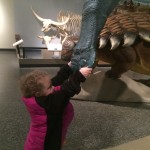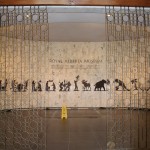The first time I saw the Provincial Museum of Alberta I was twelve years old. It was 1994 and the feature exhibition was the blockbuster “Masters of the Night: The True Story of Bats”. I remember it was dark, it was immersive, and it was really fun. Afterwards I started going to more museums, seeking them out in the various cities in which I lived, then as I got older and started travelling I would always make a point of seeing the local museum – big or small.
I didn’t come back to the Provincial Museum of Alberta until I moved to Edmonton in 2006 – a year after it received royal designation and was renamed the Royal Alberta Museum during the Queen’s 19 minute (literally) visit to the facility. I went occasionally, but it wasn’t until I had kids of my own that I fell in love with the museum.
In Love with a Museum
Living in a winter city with two small kids in a tiny house can be tough, so it was a Godsend to have an inexpensive, indoor place to go. We became members, and the three of us went most Wednesday mornings, exploring the galleries and finding new things to experience.
Their favourites became my favourites. The two life-size model dinosaurs on the second floor, features of the museum since it opened in 1967 were a must see – no visit was complete without shaking one’s hand and patting the other’s head. The dioramas, some of which were original exhibits in the museum, were also great. There was always something to see, and the interactives that were added when the Habitat Gallery reopened as Wild Alberta in 2003 were fantastic. And of course there was the bug room, where creepy-crawlies of all sorts (the museum’s entomologists would be ashamed of me) could be seen, and sometimes touched when the bug wranglers were out and about. The bug room was a much later addition, opening in 1992 as a pilot project which was so successful that it became a permanent feature the following year.
The Big Move
The museum galleries are now closed, and won’t reopen until (hopefully) December 7, 2017 – 50 years to the day that the museum first opened its doors. I can’t help feeling conflicted. The museum was an important part of our lives. We went there regularly for over two years, and spent countless hours as a family in the various galleries. I’ll remember it, but my kids won’t. They won’t remember the dinosaurs they used to hug – I hear the models won’t be in the new museum. They won’t remember all the dioramas – only eight are set to be displayed in the new building. They won’t remember playing on the grounds, having cookies and juice in the cafeteria, or the myriad of other things we did, and it makes me sad.
But I’m also happy. I’m happy they get to have a brand new, world class museum in their own city. At 419,000 square feet, the $375.5 million dollar building will be the largest in western Canada. I’m glad that there will be a new bug room, one with a “bug nursery”, where we can see the baby bugs hatch and thrive in a wonderful blending of front-of-house and back-of-house. And I am ecstatic that there will be a 7000 square foot children’s gallery with 28 separate exhibits – something the old building certainly lacked.
What’s Left Behind
Like a lot of people, the fate of the original museum building is on my mind. What is going to happen to it? The building itself is interesting. Constructed between October 1965 and May 1967, it was one of 440 Centennial projects built in Alberta to commemorate Canada’s 100th birthday. Like all Modern architecture, the selection of building material was very important. Reflecting the theme of Confederation, stone was sourced from across Canada. The walls were of Tyndall limestone from Manitoba, the slate for the sidewalks and terraces was from British Columbia, the lobby walls used Tweed pearl marble from Ontario, and the floor was black granite from Quebec. At over 200,000 square feet, the building was broken up into smaller massings so as to not overwhelm visitors.
Empty now, the lobby, with its black granite floor and marble walls has seen over 13 million visitors since 1967.
Even the site was significant. When planning the museum they wanted a location with ample room for buildings, grounds, and parking, that would also be accessible and aesthetically pleasing. Although a number of areas were looked at, including Rossdale, Walterdale, Cloverdale, Coronation Park, Terrace Heights, Mayfair Park, Laurier Park and the University Farm, they ultimately settled on Glenora. Not only did it fit their parameters, it was also above the flood plain and afforded views of the river, representing the old fur trading route, as well as the Legislature and the last site of Fort Edmonton.
As for that will happen to the building, the jury is still out. The museum is the official tenant until December 2019, so nothing will happen overnight. However, the museum is a good example of the much maligned and often dismissed Brutalist architecture. It is solidly built, less than 50 years old, has a lot of lovely features for those who care to look. I think it would be a shame to lose it.
The Museums at a Glance: Old vs. New
| Old Museum | New Museum | |
| Address | 12845 – 102 Avenue | 9810 – 103A Avenue |
| Year opened | 1967 | 2017 (estimated) |
| Architect | Alberta Public Works | Dialogue |
| Builder | Poole Construction (now PCL) | Ledcor |
| Cost | $8.6 million | $375.5 million (estimated) |
| Size | 211,000 square feet | 480,000 square feet |
| Exhibition space | 40,000 square feet | 81,000 square feet |
| Number of artifacts | 42,000 | 2.1 million |
| Paid admission | None until 1991 | Yes |
| Free parking | Yes | No |
| Awesome | Most definitely | I certainly hope so! |
Tim O’Grady © 2016




